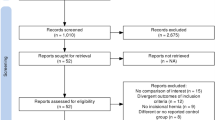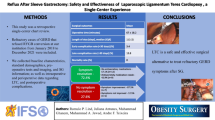Abstract
Background
Ventral hernias are a common finding during bariatric surgery; however, the risks and benefits of repair during surgery remain unclear. Using the Metabolic and Bariatric Surgery Accreditation and Quality Improvement Program (MBSAQIP) database, we examined the short-term outcomes of patients undergoing bariatric surgery with concurrent ventral hernia repair (VHR) versus bariatric surgery alone.
Methods
Patients undergoing laparoscopic Roux-en-Y gastric bypass (LRYGB) or laparoscopic sleeve gastrectomy (LSG) were included. A propensity-matched analysis was performed between laparoscopic bariatric surgery with and without concurrent VHR. The primary outcome was the 30-day major complication rate which includes but is not limited to 30-day reoperation, deep surgical site infection, and sepsis. Secondary outcomes included operative time, length of hospital stay, 30-day readmission, and 30-day mortality.
Results
A total of 430,225 patients were included, of which 4690 (1.1%) received concomitant VHR. With one-to-one propensity score matching, 4648 pairs were selected. Concurrent VHR was associated with a higher major complication rate (5.8 vs 3.8%, p < 0.001) but no significant difference in mortality (0.3 vs 0.2%, p = 0.531). Both LSG with VHR (3.2 vs 2.4%, p = 0.007) and RYGB with VHR (9.3 vs 5.7%, p < 0.001) were associated with an increase in major complications.
Conclusions
Patients undergoing VHR during bariatric surgery do not experience higher mortality. However, these patients have an elevated risk of major complications with this risk being higher among patients undergoing VHR and LRYGB. Bariatric surgeons should consider these risks when choosing to perform VHR at the time of bariatric surgery.
Similar content being viewed by others

Notes
This paper has been accepted for lecture presentation at the DDW 2019 SSAT plenary session on May 21, 2019 at the San Diego Convention Centre in San Diego, CA, USA.
References
Shettar V, Patel S, Kidambi S. Epidemiology of Obesity and Pharmacologic Treatment Options. Nutr Clin Pract 2017;32:441–62.
Lau B, Kim H, Haigh PI, Tejirian T. Obesity increases the odds of acquiring and incarcerating noninguinal abdominal wall hernias. Am Surg 2012;78:1118–21.
Praveen Raj P, Senthilnathan P, Kumaravel R, Rajpandian S, Rajan PS, Anand Vijay N, et al. Concomitant laparoscopic ventral hernia mesh repair and bariatric surgery: A retrospective study from a tertiary care center. Obes Surg 2012;22:685–9.
Angrisani L, Santonicola A, Iovino P, Formisano G, Buchwald H, Scopinaro N. Bariatric Surgery Worldwide 2013. Obes Surg 2015;25:1822–32.
Sait MS, Som R, Borg CM, Chang A, Ramar S. Best evidence topic: Should ventral hernia repair be performed at the same time as bariatric surgery? Ann Med Surg 2016;11:21–5.
Datta T, Eid G, Nahmias N, Dallal RM. Management of ventral hernias during laparoscopic gastric bypass. Surg Obes Relat Dis 2008;4:754–7.
Rao RS, Gentileschi P, Kini SU. Management of ventral hernias in bariatric surgery. Surg Obes Relat Dis 2011;7:110–6.
Eid GM, Mattar SG, Hamad G, Cottam DR, Lord JL, Watson A, et al. Repair of ventral hernias in morbidly obese patients undergoing laparoscopic gastric bypass should not be deferred. Surg Endosc Other Interv Tech 2004;18:207–10.
Lazzati A, Nassif GB, Paolino L. Concomitant Ventral Hernia Repair and Bariatric Surgery: a Systematic Review. Obes Surg 2018;28:2949–55.
Standards Manual n.d. https://www.facs.org/quality-programs/mbsaqip/standards (accessed December 2, 2018).
StataCorp. StataCorp (2015) Stata statistical software: release 15. n.d.
Rosenbaum PR, Rubin DB. Constructing a control group using multivariate matched sampling methods that incorporate the propensity score. Am Stat 1985;39:33–8.
Austin PC. An Introduction to Propensity Score Methods for Reducing the Effects of Confounding in Observational Studies. Multivariate Behav Res 2011;46:399–424. https://doi.org/10.1080/00273171.2011.568786.
Khorgami Z, Haskins IN, Aminian A, Andalib A, Rosen MJ, Brethauer SA, et al. Concurrent ventral hernia repair in patients undergoing laparoscopic bariatric surgery: a case-matched study using the National Surgical Quality Improvement Program Database. Surg Obes Relat Dis 2017;13:997–1002.
Hussain A, Mahmood H, Singhal T, El-Hasani S. Laparoscopic treatment of early small bowel obstruction after laparoscopic ventral hernia repair. Surg Laparosc Endosc Percutaneous Tech 2009;19:123–4.
Breuing K, Butler CE, Ferzoco S, Franz M, Hultman CS, Kilbridge JF, et al. Incisional ventral hernias: Review of the literature and recommendations regarding the grading and technique of repair. Surgery 2010;148:544–58.
Cozacov Y, Szomstein S, Safdie FM, Lo Menzo E, Rosenthal R. Is the use of prosthetic mesh recommended in severely obese patients undergoing concomitant abdominal wall hernia repair and sleeve gastrectomy? J Am Coll Surg 2014;218:358–62. https://doi.org/10.1016/j.jamcollsurg.2013.12.008.
Birindelli A, Sartelli M, Di Saverio S, Coccolini F, Ansaloni L, van Ramshorst GH, et al. 2017 update of the WSES guidelines for emergency repair of complicated abdominal wall hernias. World J Emerg Surg 2017;12:1–16.
Author information
Authors and Affiliations
Contributions
SK, DB, JD, and SB led study conceptualization with input from other authors. Data analysis and interpretation of results were performed by JD with the assistance of MM. MM and JD drafted the manuscript in consultation with AM, SB, NS, DB, and SK. All authors reviewed, suggested changes in analyses and presentation, and approved the final manuscript.
Corresponding author
Ethics declarations
Conflict of Interest
Muhammad Moolla and Drs. Dang, Modasi, Byrns, Switzer, Birch, and Karmali have no conflicts of interest or financial ties to disclose.Footnote 1
Ethical Approval
This article does not contain any studies with human participants or animals performed by any of the authors.
Informed Consent
For this type of study, formal consent is not required.
Additional information
Publisher’s Note
Springer Nature remains neutral with regard to jurisdictional claims in published maps and institutional affiliations.
Rights and permissions
About this article
Cite this article
Moolla, M., Dang, J., Modasi, A. et al. Concurrent Laparoscopic Ventral Hernia Repair with Bariatric Surgery: a Propensity-Matched Analysis. J Gastrointest Surg 24, 58–66 (2020). https://doi.org/10.1007/s11605-019-04291-0
Received:
Revised:
Accepted:
Published:
Issue Date:
DOI: https://doi.org/10.1007/s11605-019-04291-0



